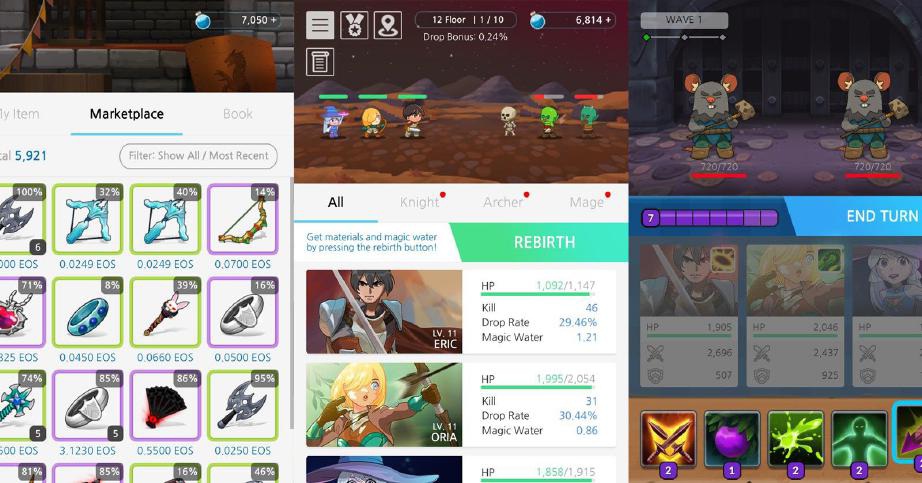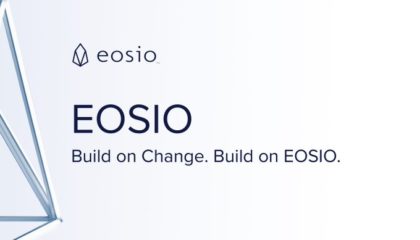Which Platform Is Best For Developing Blockchain dApps? Ethereum, EOS or TRON
Some of the features to look for when looking for a blockchain on which to develop a dApp include decentralization, high speed of transactions or throughput, transparency, security and safety for users' assets, personal data and information. But there is much more than that!
Ethereum has been around as a go-to ecosystem for many developers: Ethereum platform has a hyperactive community of developers and active community; it is regarded as more decentralized; it provides different standards like ERC20, ERC1400, ERC721, ERC223, ERC777, ERC1155 and ERC1337; and above all is seen as more tested in terms of dApp security. However, TRON and EOS, although haven’t been around for long, are equally competitive and being preferred by many today as platforms for building dApps. In some way, they are better than Ethereum: for instance, they achieve much higher throughput or transactions per second count than Ethereum.
Also, Ethereum is by far the most popular building platform for cryptocurrency developers, now hosting over 2,000 Dapps according to https://dappradar.com/, followed by Tron with about 600 dApps and EOS with about 500 dApps. Out of the total 1,445 new dapps built across the 6 largest smart contract networks, 690 were built on Ethereum and 411 and 260 on TRON and EOS respectively. This is even as EOS becomes the platform with most of active users out of the 3 billion blockchain and cryptocurrency users.
There are many options and top blockchains for dApp developers willing to develop better dApps on blockchain, and one might be interested in knowing which one to use over the other. We consider the three top -- Ethereum, EOS, and TRON. However, generally speaking, from a perspective of development, which blockchain to use will depend on the client project at hand. We try to compare these three and where all of them fit in the dApp development landscape.
As smart contract development platforms
Ethereum provides smart contracts just as does other platforms EOS and TRON, but is certainly referred to as a “battle-tested” platform for smart contract development than those other three. Ethereum has been more preferable for many developers than Hyperledger for building gaming, trading, subscriptions but Hyperledger would be more preferable for less focused applications and more B2B perspectives such as insurance and supply chain.
Ethereum’s programming language is Solidity, which was written by Ethereum developers, and unfortunately because it is not as popular as C++ or other languages, it misses a lot of features. Tron also like Ethereum, uses Solidity since it uses a fork of the Ethereum Virtual Machine.
In comparison, EOS programming language is C++ which is a very popular programming language and one that is already developed quite extensively. With C++ you get to write faster, easier and more high-quality smart contracts. C++ allows developers to create more complex and bigger applications with ease. Therefore you would want to choose either if depending on the language you are experienced or familiar with or one with which you want to develop your dApp.
Ethereum’s DeFi dapps have hit $1B in assets represented in its smart contracts this month from just $600M in December last year. On Tron, these types of dApps are hard to find. The number of financial dapps increased by 610% and their transaction volume has increased by 251%, which makes Ethereum even more potential as a platform for financial dapps. deFi dapps had 1M active users in 2019.
The amount of blockchain gaming users increased 162% as expected since 2018. Tron, which leads in gaming applications. However, the investment hype around these dapps decreased as shown by a falling volume which recorded a 60% drop compared to 2018.
Ethereum’s DeFi dapps have hit $1B in assets represented in its smart contracts this month from just $600M in December last year. On Tron, these types of dApps are hard to find. The number of financial dapps increased by 610% and their transaction volume has increased by 251%, which makes Ethereum even more potential as a platform for financial dapps. deFi dapps had 1M active users in 2019.
The amount of blockchain gaming users increased 162% as expected since 2018. Tron, which leads in gaming applications. However, the investment hype around these dapps decreased as shown by a falling volume which recorded a 60% drop compared to 2018.
Like TRON, EOS is also labelled “gambling” or “high-risk” platform although DeFi apps may start to emerge more on the platform. Particularly they aren’t as popular on these platforms because of issues around security and trust needed to build financial dapps.
Transaction volume, community of users and user activity
In terms of community, which can be defined as the total amount of interactions with dApps on these blockchain platforms, people doing transactions, Ethereum attracted a total of around 1.42 million last year, including 1.28M new users and 137K old users; This figure accounted for 10% of the total amount of active users and was highest compared to EOS and Tron active users. Not to forget to mention that the total number of daily active users shot 2 folds compared to 2018 stats. EOS had 518 K while TRON had 967 k users. Dapp users on EOS, however, experienced a 30 percent drop in its active daily dapps. The network was experiencing an average of nearly 80,000 (79,749) users using dapps on EOS every day.
Although currently the highest number of dApps type on Ethereum is the marketing and gaming category, followed by gambling and high risk category, and then exchanges and DeFi or decentralized finance, Ethereum is strongest case for finance dApps with nearly half of the blockchain’s dapp users having used a decentralized finance app in 2019. These applications having locked about $700 million worth of ETH tokens as of late means Ethereum promises a safer investment exposure than EOS and Tron.
According to the 2019 data, nearly half of active dapp users on Ethereum had used DeFi dapps in 2019. 70% of the volume generated by ETH token was the use of decentralized exchanges and financial services such as lending. So again, Ethereum looks like a warmer place if you are looking for a warmer place to be.
Of the 3.1 billion transactions that happened across 24 crypto networks in the last one decade, as found out in a research by Blocknative Ethereum and Bitcoin are clear winners. Bitcoin saw 259.2 million transactions while 242.8 million transactions took place on the Ethereum network. Nevertheless, EOS and Tron haven’t existed that long and are showing strong signs because of their versatility and speed. However, considering the short amount of time these have been operating, they are more active.
EOS, according to the Dapp, recorded the highest activity in 2019, with 479 or 97% out of 493 dapps being active. Steem had second highest with Etherem and NEO recording lowest activity. In other words, EOS would be much more preferable for a developer looking for a network with more active users although Ethereum still has highest users in total. Not active users alone, EOS leads in terms of transaction value volume and total number of transactions.
According to Dapp.com data, the 9 leading blockchain networks added 58.5% of volume in 2019 compared to 2018 transactional volume. EOS generated a volume of $5 billion or 50% out of the total $10 billion (excluding non-native blockchain token eg. ERC-20 token transactions) in 2019. EOS has $14.3 million, the highest on-chain daily volume, Ethereum has some $8.7M, and TRON sits at third with $3.4M
EOS also led in terms of the share of the total number of transactions on the 9 leading blockchains, with its EIDOS contributing over 2.3 billion of transaction volume. The blockchain also leads in account usage among dApps showing a close to 50% rate meaning one account uses EOS dapps in every 2 accounts activated.
Ethereum also, however, leads in total number of transactions ever done because it has been around for much longer.
Developer community and developer tools
One clear advantage about Ethereum’s development platform – the blockchain – is the vast number of developers from which to get support, templates and help and there is a lot of community work from which to borrow if you are a developer looking for such; and secondly, there are already plenty number of development tools which can help a lot from starting a local blockchain node to unit testing smart contracts with JavaScript. It has more developer tools than any other blockchain development platform. That’s not to mean that TRON and EOS are unpopular; these platforms have been growing quicker than did Ethereum.
By last year, Ethereum nodes were being run in 89 countries and out of those, 59 were being run at universities and colleges. The network had 13,225 smart contracts powering dapps and 200,360+ active Ethereum developers. About $175K grants had been awarded to projects developing on Ethereum.
The number of developers on Ethereum are four times more than those on EOS or TRON. While Ethereum has around 2,000 Github watchers and roughly 445 developers contributing to the ETH codebase, Tron has about 309 Github watchers and 118 developers that have contributed to the TRX Github repository. Ethereum has 9,200 forks while Tron has 673 forks.
Having a huge community of dApp developers means a lot for Ethereum just as is with any other platforms. Because not only does trust comes in when many developers can trust to develop working dApps on the platform for so long, but when it is possible to secure assets and those of their customers; a huge community base ensures that things keep moving as more dApps will be built which helps thrive the internal economy.
In most cases, a new blockchain will be riddled with bugs lying undiscovered due to untested features and aspects – bug discovery ecosystems, auditing and code review ecosystems, and discussions around ccrypto projects on Ethereum are much more lively, bigger and active than in other blockchains. There still are better chances to finding more experienced auditor to review your code than in new blockchains.
Transaction throughput, decentralization, governance and interoperability of blockchains
EOS has claimed it can achieve 4,000 TPS, which is by far the highest of the three blockchains. Therefore, it has the highest throughput among the four protocols although this number reflects upper limit or capacity of the network can achieve rather than amount of transactions it handles every day. The required throughput currently is about 80 TPS.
Ethereum is still PoW but according to a recent announcement, it will be able to manage 3000 transactions per second after a series of updates and improvements but currently stands at a much lower rate. TRON can manage up to 2000 TPS.
In terms of consensus protocol, which is another big thing that would influence a developer choosing any of the blockchain platform, EOS uses DPoS same as Tron. For development, while EOS utilizes web assembly virtual machine, Tron uses a fork of the Ethereum Virtual Machine, meaning it also uses Solidity as a programming machine. This means Tron and Ethereum are compatible and it is possible to port Ethereum dApps to TRON. The compatibility is an advantage for developers who want to leverage one blockchain features that may prove better than the other blockchain’s features. TRON, however, recently announced they will be moving to Liquid network from Ethereum.
But TRON dApps aren’t compatible to EOS neither is EOS compatible with TRON yet. EOS, which is already seeking compatibility with Ethereum, can process smart contracts faster, reducing the impact of a significant roadblock for developers.
In other words, for now, a developer looking among the three blockchains for a more interoperable network would go for Ethereum although there are much better “solutions” out there.
The consensus algorithm to choose will affect other factors as well. Currently, Proof of Work is not regarded as energy efficient option for mining when you look at other options in PoS. EOS uses the BFT-DPoS consensus mechanism, which means it is Byzantine Fault Tolerance DPoS. DPoS is more energy efficient for billing rights.
Byzantine Fault Tolerance, which is used in EOS, improves block confirmation speed. With it, the verification does not verify the block content by the super node one by one in the order of the block, but let the block node become the master node. After the block, the remaining 20 nodes are broadcasted at the same time and verification feedback of the node is obtained. The block becomes irreversible if more than 2/3 of the nodes pass verification. The blockchain can achieve a block speed of 0.5s with 1 s realizing irreversibility. EOS uses the WASM virtual machine and intends to offer support for other programming languages in future, in addition to C++.
EOS super nodes take turns to become masternode according to their geographical distribution, minimizing network delay between supernodes and stipulates that each super node continuously produces 6 blocks. This makes sure it will avoid missing blocks due to excessive blockout speed.
TRON uses Delegated Proof of Stake (DPoS) where 27 Super Representatives (SRs) produce blocks for the network. Every six hours, TRX account holders who freeze their accounts get to vote for a selection of candidates and the top 27 become the SRs. The basis for voting for SRs may include a variety of things such as based on project proposals that encourage adoption of the blockchain.
About governance, in Tron, only the block producers can propose and vote for changes to the network attributes. In comparison, EOS allows any token holder to propose and vote for changes to the network. The changes must then be implemented by 15/21 block producers. EOS allows token holders to delegate power to a proxy to vote on their behalf enabling a true liquid approval voting system.
Ethereum, which is still Proof of Work but planning to move onto a Proof of Stake model. With Ethereum, which does not use voting system like is the case with EOS, Dash or Tezos, designated developers implement the necessary improvements after the decision process.
But even after moving to PoS, Ethereum does not intend to have an on-chain governance model such as delegated proof of stake (DPoS). The latter tends to provide administrative responsibilities to those with higher amount of coins to stake hence a form of centralization. Those large entities with large amount of coins will have large block rewards than an individual user with an average amount of cryptocurrencies. The off-chain governance model on Ethereum is based on Ethereum Improvement Proposals (EIPs) which are proposals that get voted off-chain and which are proposed by individuals through GitHub and considered by others after which they are discussed and deliberated on a large scale and voted for after which the passing ones get adopted.
Ethereum may be the most decentralized given its fast number of nodes and distribution, and most secure of the three but scalability is another thing, with PoS networks such as TRON and EOS providing more scalability than Ethereum. Transaction throughput or amount of transactions a blockchain can do in a second, as has been seen, is much higher in TRON and EOS. Therefore, for a developer who is looking for more scalable stuff, EOS and TRON may be the ones to go for although again as said Ethereum is moving to PoS.
For most developers, the choice between decentralization and scalability, and indeed security, is a must consideration for now when choosing a platform on which to develop because it is hard to achieve all the three. In most cases, it is about a compromise of one for the other. But then again, it comes down to what it is you are developing and which blockchain is most suitable for the project.





